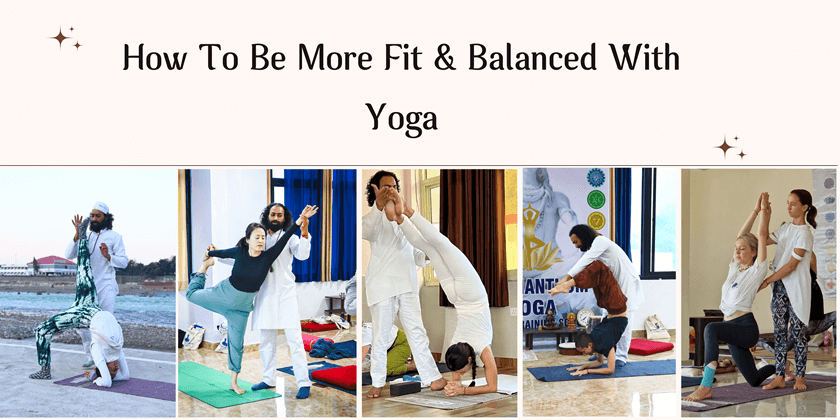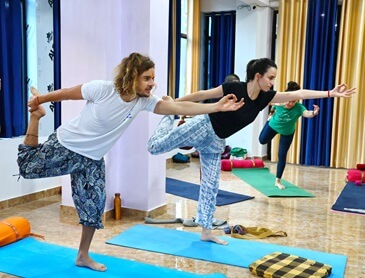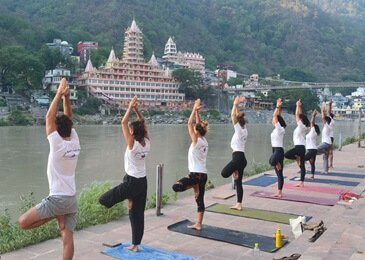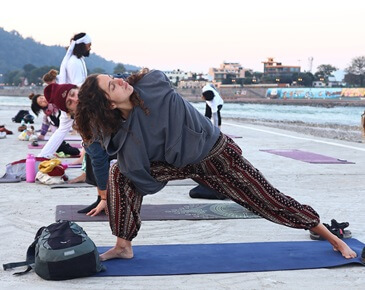
15 Dec 2023
How To Be More Fit & Balanced With Yoga
Achieving both physical and mental fitness necessitates regular engagement in learning and practicing yoga. Through consistent yoga practice, you can enhance your flexibility, balance, and strength, leading to improved physical and mental well-being. This blog aims to provide guidance on incorporating yoga into your routine to foster greater fitness and balance in your life.
Yoga – Its Origin and Purpose:
With a history dating back 5,000 years in ancient Indian philosophy, yoga is a comprehensive set of practices designed to enhance physical and mental well-being. Rooted in the pursuit of harmony among the body, mind, and environment, the teachings were traditionally transmitted from master teacher to student, preserved through both written texts and oral tradition.
The Yoga Sutra, authored by the Indian sage Patanjali around 2,000 years ago, stands as the earliest written documentation of yoga and serves as the foundational text for modern yoga. This ancient treatise provides guidance on mastering the mind, emotional control, and spiritual growth. Over the centuries, yoga evolved through various schools of thought as practitioners passed down its principles, leading to its global popularity.
Modern yoga incorporates diverse styles that blend physical postures, breathing techniques, and meditation or relaxation. In recent times, it has gained popularity as a form of physical exercise, emphasizing poses to improve mind-body control and overall well-being. The 1920s and 1930s witnessed a surge of interest in postural yoga, initially in India and later spreading to the Western world.
Yoga, often depicted metaphorically as a tree with roots, a trunk, branches, blossoms, and fruits, comprises six branches, each representing a unique focus:
- Hatha Yoga: Priming the body and mind physically and mentally.
- Raja Yoga: Involving meditation and adherence to the "eight limbs" of yoga.
- Karma Yoga: A path of service aiming for a future free from negativity.
- Bhakti Yoga: Focusing on devotion, channeling emotions positively.
- Jnana Yoga: Centered on wisdom and intellectual development through study.
- Tantra Yoga: Involving ritual, ceremony, or consummation of a relationship.
- Approaching yoga with specific goals in mind can guide individuals in choosing the appropriate branch. In the West, several popular yoga schools incorporate some or all of the limbs described by Patanjali, known as Asthangayoga. These eight limbs encompass:
- Yama: Rules for successful living in society.
- Niyama: Techniques for managing and purifying oneself.
- Asana: Posture techniques for physical and mental balance.
- Pranayama: Breathing techniques for balance.
- Pratihara: Techniques for detaching the mind from the senses.
- Dharana: Concentration techniques for mental balance.
- Dhyana: Meditation techniques for mental balance.
- Samadhi: Ultimate advanced meditation techniques for universal consciousness.
- The practice involves awakening Kundalini Shakti, the serpent power located at the base of the spine. Through various techniques, this latent energy rises through Chakras, corresponding to different endocrine glands. Yoga asanas contribute to achieving Supreme Harmony or Samadhi, the eighth limb, resulting from the culmination of all seven limbs of yoga.
Yoga, as a holistic practice, brings harmony to the physical, vital, mental, psychological, and spiritual facets of human personality. Just as the limbs constitute the human body, the various limbs of yoga function in unison. Perfecting even one limb of yoga can lead to the simultaneous development of all other limbs without significant effort on the practitioner's part.
Purpose of Yoga:
The original intent of yoga was rooted in spiritual development practices, aiming to train both the body and mind for self-observation and heightened self-awareness. Yoga sought to cultivate qualities such as discernment, awareness, self-regulation, and a heightened state of consciousness in individuals. However, as a divergence emerged between those pursuing physical development and those seeking spiritual growth, there has been a notable disconnect from the original purpose of yoga.
Yoga, fundamentally, is designed to be a system that enhances awareness while minimizing the occurrence of diseases. The increasing emphasis on physical aspects, to the detriment of inner experience, has resulted in a disconnection between practitioners and their own bodies.
To gain acceptance in the American mainstream, yoga strategically presented itself as a versatile tool offering numerous benefits, such as stress reduction, enhanced relaxation, and improved flexibility. Over time, it has evolved into a practice recognized for cultivating aerobic capacity and building physical strength. Despite this shift, the essence of yoga as a holistic approach for increasing awareness and promoting overall well-being remains integral to its purpose.
Yoga and Mindfulness:
Mindfulness, an integral part of ancient meditations and yogic practices, has been cultivated for centuries as a pathway to momentary engagement and inner peace. It constitutes a method of discovering tranquility, emphasizing a heightened awareness of the present moment. In our interaction with the world, the six senses—sight, smell, sound, taste, touch, and thought—serve as channels through which we perceive, with the mind evaluating and labeling each experience.
At its essence, mindfulness is a form of meditative awareness that directs attention to the unfolding moment. It involves observing and experiencing everything without judgment or categorization, refraining from labeling occurrences as pleasant or unpleasant. Mindfulness is a simple practice that can be incorporated into various daily activities, offering a transformative impact on physical and mental health. Scientists are increasingly recognizing and documenting the myriad benefits of mindfulness, including enhanced overall well-being.
The cultivation of mindfulness involves a continuous and repetitive focus on the object of awareness. This can be achieved through breathing techniques and physical yoga postures, both of which contribute to staying present by heightening awareness of the breath and facilitating the release of stress and toxins from the body.
Developing mindfulness allows individuals to express their true selves and connect with authentic aspects of their being that may have gone unnoticed. Contrary to a common misconception, mindfulness does not entail silencing thoughts; rather, it is the act of present engagement that unlocks the door to mental stillness. By immersing oneself in the task at hand, distracting thoughts find no foothold in the quiet space of the mind, and judgment dissipates. In this state, one can simply be, experiencing the moment without the interference of evaluative thoughts.
Mindfulness is not a fixed or permanent state of awareness; instead, it is an ongoing process that deepens the richness of our experiences. It clears the path for a more profound connection with the present, free from the clouding influence of judgments based on notions of good, bad, right, or wrong.
Sleep Better with Yoga:
Incorporating yoga into your routine can significantly enhance the quality of your sleep. The soothing poses, stretches, and accompanying calming breathing exercises can be particularly effective in alleviating stress that may hinder a restful night's sleep. Individuals dealing with insomnia may find that a daily yoga practice over eight weeks can lead to faster sleep onset, increased overall sleep duration, and improved ability to return to sleep if waking up during the night.
Yoga Nidra, also known as yogic sleep, stands out as a potent meditation technique within the realm of yoga, offering ease of development and maintenance. This five-stage process begins with a body scan, engaging one's physicality, and progresses through meditation on the breath, emotional state balancing, visualization, and self-healing. The inclusion of a positive intention, known as Sankalpa, adds purpose to the session.
During Yoga Nidra, awareness traverses the entire body, inducing deep relaxation that contributes to health, mental tranquility, and heightened awareness. This practice serves as a means of self-mastery over the autonomic nervous system, accessible through practical techniques. To prepare the mind and body for Yoga Nidra, relaxation exercises and pratyahara, or the withdrawal of the senses, are employed. These actions balance the brain's right and left hemispheres and stimulate the subtle energies of prana, the vital life force.
To enhance your sleep preparation, consider incorporating the following yoga poses:
Legs Up the Wall:
Lie on your back and place the back of your legs against a wall, keeping them straight. Relax into the position, holding it for at least 30 seconds while focusing on your breath.
Lying Butterfly:
Lie on your back, press the soles of your feet together, and let your knees fall outward. For added comfort, place a pillow under your knees.
Corpse Pose:
Lie on your back with legs straight, arms by your sides, and palms facing upward. Breathe slowly, concentrating on your inhalations and exhalations.
Recognizing the correlation between quality sleep, weight loss, and the role of yoga in promoting restful sleep, it becomes evident that integrating yoga into one's routine can contribute to overall well-being, potentially aiding in weight loss efforts.
Yoga for Weight Loss:
The combination of yoga and a healthy diet has demonstrated its effectiveness in promoting weight loss while nurturing overall mental and physical well-being. Yoga fosters mindfulness, creating a heightened awareness of the body and its needs.
While not traditionally categorized as an aerobic exercise, more active forms of yoga can be a valuable tool for weight reduction. The multifaceted nature of yoga, encompassing strength, flexibility, balance, and endurance, contributes to its effectiveness. Different types of yoga can burn anywhere from 180 to 600 calories per hour, catering to various preferences and fitness levels.
Here are some impactful yoga asanas for weight loss:
1. Suryanamaskar (Sun Salutation):
Comprising a sequence of 12 yoga postures, the Sun Salutation is a comprehensive workout for the entire body. Executed at a faster pace, it serves as a cardio exercise and aids in weight loss. The postures stretch abdominal muscles, making it an effective solution for reducing belly fat. Regular practice purifies the blood, enhances blood circulation, and promotes the proper functioning of vital organs.
2. Veerabhadrasana (Warrior Pose):
This pose, also known as the Warrior Pose, strengthens hamstrings, thighs, legs, and ankles. Performing variations of Veerabhadrasana engages muscles effectively, contributing to calorie burning and muscle toning. The pose stimulates abdominal organs, increasing stamina and supporting sustained physical activity.
3. Trikonasana (Triangle Pose):
An excellent exercise for weight loss, Trikonasana improves digestion and reduces fat around the waist. The lateral motion involved aids in burning fat and building muscle in the thighs and hamstrings. It enhances balance, concentration, and overall body circulation.
4. Purvottanasana (Upward Plank Pose):
This pose strengthens the core and improves upper body strength. Purvottanasana stretches and tones the shoulders, chest, lower back, triceps, and hamstrings, making it an effective yoga asana for weight loss.
5. Dhanurasana (Bow Pose):
The Bow Pose provides a maximum stretch to the abdomen and abdominal sides, aiding in shedding and burning fat in these regions. Regular practice massages abdominal organs for improved digestion and strengthens the thighs, chest, and back.
Incorporating these yoga poses into a routine, combined with mindful eating, supports a holistic approach to weight loss and overall well-being. Yoga not only contributes to physical fitness but also fosters a positive connection between the mind and body, enhancing the overall weight loss journey.
Tips for Maximizing Your Yoga Practice:
Yoga is an art that unites the soul, mind, and body, offering a myriad of health benefits. To harness its full potential, yoga should be embraced as a holistic package that aims to cleanse and rejuvenate the body from the inside out. Here are three tips to enhance your yoga practice:
1. Regular Practice:
Make yoga a consistent part of your daily routine to experience its profound benefits. Regular practice not only aids in weight reduction and boosts immunity but also contributes to overall health maintenance and disease prevention. As you delve deeper into your yoga journey, you'll notice improvements in:
- Flexibility
- Blood circulation
- Bone health
- Body sculpting
- Focus and energy modulation
- Anxiety reduction and metabolism improvement
- Mindfulness cultivation
- Weight loss facilitation and improved sleep quality
- The continuous process of yoga practice yields lasting benefits that extend beyond physical well-being.
2. Healthy Diet and Yoga:
Recognize the integral connection between a healthy diet and yoga. According to Ayurveda, the qualities of food can be categorized into Tama (slow, lethargic, bland), Sattva (purity, harmony), and Raja (hot, spicy, fast). Yogis believe that Sattvic food, representing purity and harmony, is most suitable for those following a yoga regime. This type of food nourishes the body and promotes a peaceful state. Avoiding Rajasic (overstimulating) and Tamasic (bland or lethargic) foods complements and nurtures your yoga practice, fostering a mindful eating practice.
3. Patience with Yoga Practice:Understand that yoga is a transformative practice that unfolds over time. Be patient with yourself and allow the practice to gradually influence your life. The transformative power of yoga goes beyond physical strength and flexibility; it extends to emotional and mental well-being. To fully embrace the transformative journey, practice patience and consistency. Yoga is not merely about getting stronger or more flexible; it offers long-term benefits that add significant value to life. As you patiently engage in yoga, you may find yourself opening up to new perspectives, living with greater awareness and intention, and fully embracing the experiences life presents. Make yoga a part of your daily routine to cultivate a strong, supple, flexible, and healthy body. Remember, yoga is not a religion; it's a science—a science of well-being, youthfulness, and the integration of body, mind, and soul.


